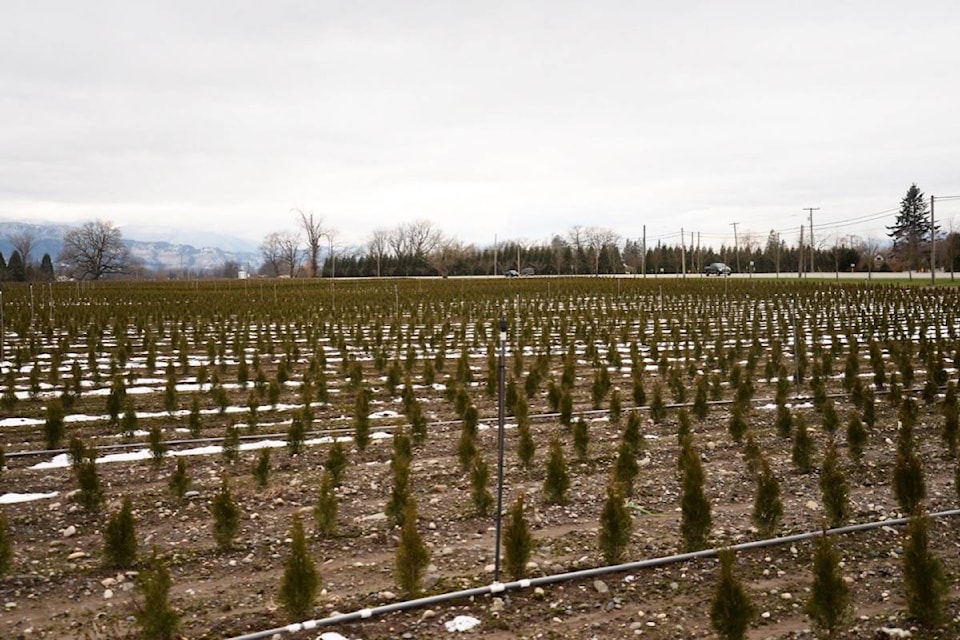UPDATE: Since publication, the developers who submitted a piece of Agassiz farmland for exclusion from the Agricultural Land Reserve have appealed the Agricultural Land Commission’s decision to deny exclusion. An appeal hearing will determine the fate of the land in question.
Farmland is valuable, but should it be prioritized in a growing town?
For self-described agriculture land preservation advocate Ken Vanderhoek, the answer to that question is a firm yes.
As a lifetime Agassiz resident and member of the Kent Agriculture Advisory Committee (KAAC), Vanderhoek has seen the way agriculture protection has changed in his community and kept an eye on decisions made by the Agriculture Land Commission (ALC), a provincial body with decision-making power over what happens on B.C. farmland.
While he hasn’t always been happy with the ALC’s decisions, Vanderhoek was impressed by the commission’s recent choice to deny an Agricultural Land Reserve (ALR) exclusion request from developers for a piece of land off McDonald Road in Agassiz.
“It’s high-value land and the ALC understood that,” he said. “I was thrilled.”
READ: 2016 record year for agriculture sales and profits
The decision was released Dec. 18, and with the 60-day appeal period ending this week, Vanderhoek is happy to know the land is safe from development – for now. The ALC’s decision ensures the land in question, bound by Haig Highway, Highway 9 and McDonald Road, will remain farmland – protected in the ALR.
Although the District of Kent’s endorsement for last year’s exclusion application was based on accommodating future residential growth, proposed compensations were certainly part of the municipality’s decision. The applicant’s proposition included ALR inclusion of an 18.2-hectare piece of Kent land and up to $1 million in amenity contributions for agricultural improvements in the area.
This wasn’t the first time the land was brought forward for development. The parcel was designated for residential development in the District of Kent’s 2001 and 2014 official community plans and brought to the commission for ALR exclusion on each occasion. It was even submitted for exclusion with the Fraser Valley Regional District’s 2004 Regional Growth Strategy.
But every application was denied based on the agricultural capability of the land, which, according to the investigative panel, outweighs the reasons it was submitted with plans for residential development – namely its proximity to the Kent townsite and associated amenities.
Vanderhoek hopes the most recent decision will set a precedent for other agricultural properties in the district.
“Anyone that knows a little bit about agriculture can see what that property can produce,” he said, citing the land’s history as a dairy and vegetable producer.
“It is a beautiful piece of farmland … I do think that this is going to take the heat off,” he added. “This would have been a lucrative piece for a developer and they didn’t let them [develop] so … I feel it really sets a precedent.”
The B.C. government recently began moving forward with a plan for evaluating the ALR and ALC and is seeking input from stakeholders and the public to develop recommendations for change.
READ: Public input from across B.C. now being sought on revitalizing the ALR
Vanderhoek has seen the commission adjusted by provincial powers before.
Since its inception in 1973, the ALR has been amended and reformed – with adjustments to everything from land use to commissioners’ term lengths.
Last year, Premier John Horgan campaigned with a promise to “revitalize the [ALC] for the 21st century,” and the Minister of Agriculture’s advisory committee recently released a discussion paper for consultation where issues like the “temporary and adjustable” perception of ALR boundaries are addressed.
“The perspective that the ALR is available for urban uses perpetuates land use pressure on farmland,” reads the paper, adding that the ALR boundary has been adjusted over the past 45 years by local government planning exercises and over 48,000 individual applications.
“Continued speculation of this nature results in a focus on applications made by individual landowners to modify the ALR and detracts from pro-active work such as … the preservation and encouraging farm use mandate.”
Kent has been invited to participate in a regional stakeholder consultation with the province, and mayor John Van Laerhoven – who was excluded from all council decisions made on the McDonald Road property due to his own home’s proximity – is looking forward to attending and bringing his two cents to the table.
“I think there needs to be a focus on food production because food security is important [and] our population here is growing,” he said, adding that he is mostly interested in hearing the feedback the general public offers the province.
As a former farmer, current Agassiz resident and lifetime supporter of agricultural land, Vanderhoek said the revitalization efforts are a good idea.
“I know that it won’t affect me in my lifetime, but I try to think for generations to come,” he said. “We live in the Fraser Valley [where] the soil is so fertile and very valuable.
“We have to be responsible stewards of our earth,” he added. “Without water, air and food, we, as a humanity, do not survive. It’s as simple as that.”
The public is encouraged to submit ideas and feedback about the ALR and ALC online at engage.gov.bc.ca before April 30.

